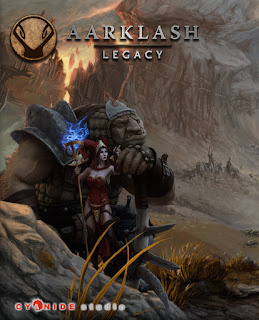An RPG or RTS?
So when Aarklash: Legacy showed up in my Steam discovery queue tagged with 'rpg' and 'real-time with active pause' and overall very positive user reviews, I bought it immediately to satisfy my desire to play a non-turn-based isometric role-playing game for a change. It kind of was that but it did not exactly feel like the RPGs of old.
It is as if Cyanide Studio had an engine for a Dota-like or a real-time strategy game with heroes, and then decided to make an RPG instead. You start with a full, four-person party right away. Each character -- or unit, as the game calls them -- has four abilities that feel very like if they had come from Dota or something similar. At least they have some branching upgrade options instead of just growing linearly in effectiveness.
I think the lack of customization is what makes Aarklash: Legacy not a proper RPG. I mean, it does not have role-playing either but even action RPGs usually have at least some different gear and skill choices that affect your playing style or at least character appearance. The loot in this game comes in four different kinds of trinkets that only have bland stat bonuses. Your job is merely to equip them on a character that benefits most from them.
The active pause is what separates Aarklash from the RTS genre, too. The game has some Steam achievements for playing parts of the game without using it, but I would say that most of the time it is very much needed to keep everyone standing. Especially in late game, reviving a fallen character is difficult due to the number of enemies in every encounter.
Tactical combat
You can see what skills enemies have from their info sheets as well as from the incantation icon when they are casting something. For boss monsters this is important as they cannot be silenced and they always have at least one skill that instantly kills. I think the Hydra had the most with four different ones.
Most of the death-causing skills are area targeted, requiring the player to move the characters away or close to the boss, or spread out to avoid a spell chaining to near-by heroes. It was like playing an MMORPG boss fight by yourself. The final boss in fact reminded me of the Zul'Gurub Hakkar fight in World of Warcraft.
As long as you read the ability tooltips, it is pretty difficult to fail at the boss encounters. The standard fights can be a lot harder, however. They sometimes lasted quite long until I figured out who I should be focusing first. Silence seemed like the most important thing to have. And Nella's Elemental Storm was rather good at applying it.
The combat is most of the time fairly entertaining but it can get monotone at some places. For instance, the vault of the goldmongers in Act II has two floors with nearly identical layout and fights. It also has an overabundance of puzzles. They are not too difficult but I think there just are a few too many in that particular location.
The game lasted about 15 hours for me. It has some replay value if you want to try different party setups (there are 8 characters in total you can switch around at will) or go for Steam achievements. But I would say that it does not have a lot of going for it. Torchlight II is at similar price point but has way more content. Aarklash: Legacy can be a worthwhile purchase on sale, however. (I paid 3 euros for it.)








No comments:
Post a Comment